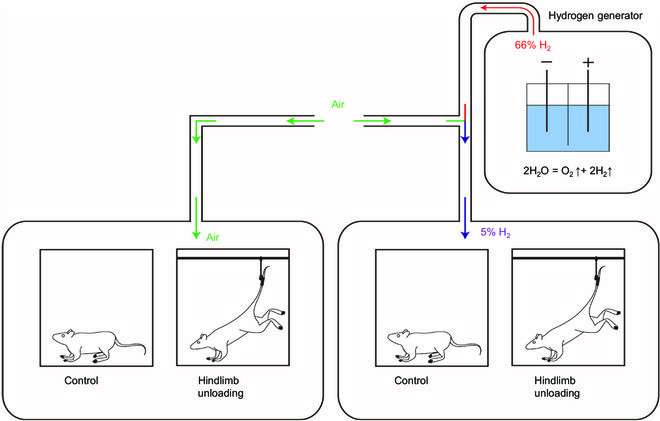This article has been reviewed according to Science X's editorial process and policies. Editors have highlighted the following attributes while ensuring the content's credibility:
fact-checked
proofread
Examining the protective effect of hydrogen inhalation on declining brain function under hindlimb unloading conditions

Astronauts are affected by various physical and chemical factors during space flight, resulting in a series of pathological and physiological changes. Many studies have shown that space flight causes oxidative stress and induces brain disorder in astronauts, negatively affecting neuronal function and brain structure.
However, the underlying mechanisms and possible countermeasures must be further explored. Moreover, it is observed that hydrogen has preventative and curative effects on ischemia–reperfusion injury, ionizing radiation injury, inflammatory diseases, and metabolic and neurodegenerative diseases. Increasing evidence demonstrates that hydrogen can act as a therapeutic antioxidant.
In a research paper recently published in Space: Science & Technology, authors from China Astronaut Research and Training Center, Beijing, China, Beijing University of Technology, Beijing, China, and National Institutes of Health, Baltimore, MD, U.S., carried out research to confirm the protective effect of hydrogen inhalation on declining brain function under hindlimb unloading conditions and disclose the underlying mechanism, which provides a potential strategy for astronauts' health.
First, the authors explain the experiment materials and methods. In the experiment, specific pathogen-free (SPF) facility Sprague-Dawley male rats are purchased from Experiment Animal Center of Wei Tong Li Hua (Beijing, China) and are maintained at the SPF facility of China Astronaut Research and Training Center in SPF with 12-h light/dark cycle at ambient temperature and humidity and fed a standard chow diet.
After seven days, the rats are randomly divided into four groups: 1) control (Ctrl) group, where rats were kept under normal conditions; 2) Ctrl + H2 group, where rats were treated with about 5% hydrogen under normal conditions for 90 minutes each time, two times per day; 3) HU, where rats were treated with hindlimb unloading; and 4) the HU + H2 group, in which rats were treated with about 5% hydrogen under hindlimb unloading conditions for 90 minutes each time, two times per day.
The 5% H2 was obtained by mixing the H2–O2 (66% hydrogen and 33% oxygen) generated by the hydrogen/oxygen generator and air. All the animal experiments were approved by the Committees of Animal Ethics and Experimental Safety of the China Astronaut Research and Training Center.
After 28 days of hindlimb unloading, the researchers performed behavioral assessments; neurotransmitter level analysis; histological analysis; assays for GSSG, GSH, MDA, SOD, and CAT; targeted metabolite profiling; mRNA sequencing; RNA extraction and real-time PCR; western blotting; and statistical analysis.
Then, authors presented their experiment analysis results, summarizing them in four points:
- Hydrogen inhalation improved brain function and alleviated the pathological damage in hippocampus induced by hindlimb unloading.
- Hydrogen inhalation ameliorated the level of oxidative stress induced by hindlimb unloading in the rat brains.
- Hydrogen inhalation ameliorated the perturbation in glucose metabolism induced by hindlimb unloading in the rat brains.
- The potential mechanism of hydrogen in ameliorating unloading-induced rat brain dysfunction may work this way: hindlimb unloading may induce cognitive defects via PGC-1α and BDNF by influencing the expression of RGS13, while H2 alleviates these effects.
This study suggests that hydrogen plays a protective role in hindlimb-unloading-induced brain damage, which is closely related with the obvious effect of hydrogen treatment in alleviating antioxidant activities and regulation on glucose metabolism.
The changes of PGC-1α and BDNF, the key regulators of metabolism and brain function, are potentially involved in this process. The underlying mechanism need to be further explored. The function of hydrogen on brain protection provides a potential protective measure for astronauts during space flight.
More information: Xiaoyan Jin et al, Hydrogen Inhalation Ameliorates Oxidative Stress and Glucose Metabolism Disorder in the Brain of Hindlimb Unloading Rats, Space: Science & Technology (2023). DOI: 10.34133/space.0027



















